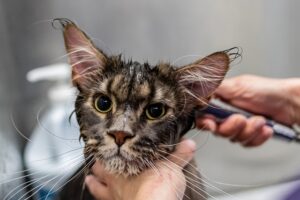Cat Behavior
Training Your Cat: Tricks, Tips & Techniques
Understanding your cat’s behavior is the first step towards training them. Cats are naturally curious and playful creatures who enjoy exploring their surroundings. They also have a tendency to be independent and can sometimes be stubborn or uncooperative during training sessions. However, with patience and persistence, you can teach your feline friend some impressive tricks! Here are some tips for proper cat care that will help keep your furry companion healthy and happy:
1. Feed your cat a balanced diet consisting of high-quality protein sources such as chicken, fish, or turkey. Avoid feeding your cat too many carbohydrates like grains or corn which can lead to weight gain and other health issues.
2. Provide your cat with plenty of fresh water daily. Make sure it’s in a clean bowl and change it regularly to prevent bacteria growth.
3. Brush your cat’s teeth regularly using a soft bristle brush and veterinary approved toothpaste. This will help maintain good dental hygiene and prevent gum disease.
4. Keep your cat up-to-date on vaccinations and parasite control medication. Consult with your veterinarian about the best schedule for these important treatments.
Now let’s move onto how to train your cat using techniques and tactics that work well:

Norwegian Forest Cat Photo by Maverick F: https://www.pexels.com/photo/close-up-photo-of-a-furry-cat-10819606/
Trick Training
Cats love to learn new things and perform tricks for treats. Start by teaching simple commands like “sit” and “stay”. Hold out a treat above your cat’s head while saying “up” until they reach up to grab it. Once they understand this command, gradually increase the difficulty level by asking them to sit or stay for longer periods of time. You can also try teaching your cat to fetch objects or jump through hoops. Just make sure not to overwhelm them with too much information at once.
Clicker Training
This technique involves using a clicker (a small handheld device that makes a clicking sound) to mark desired behaviors. First, introduce your cat to the clicker and show them what it does. Then, use positive reinforcement by clicking when your cat performs the trick correctly and giving them a treat. Over time, your cat will associate the click with the reward and begin to anticipate it. Clicker training works particularly well for cats who are hesitant or fearful around humans.
Tactile Stimulation
Gently petting or scratching your cat behind the ears or under the chin can provide comfort and relaxation. Additionally, providing your cat with interactive toys such as laser pointers or feather wands can stimulate their natural hunting instincts and encourage playtime activity.
Communicating With Your Feline Friend
Finally, remember to communicate with your cat frequently throughout the day. Speak in a calm tone of voice and avoid startling movements that may cause stress. Pay attention to body language cues such as ear position, tail movement, and facial expressions to better understand your cat’s mood and needs. By understanding your cat’s behavior and providing them with proper care and training, you can create a strong bond and build a lasting relationship filled with joy and laughter.
Communicating with Your Cat: Understanding Their Body Language and Needs
Understanding your cat’s body language is essential to understanding their needs, emotions, and behavior. Cats are often misunderstood as being aloof or unsociable, but they have a complex system of communication that can help you connect with them on a deeper level. Here are some common signs to look out for in your feline friend:
1. Ears: If your cat’s ears are pointed forward, it means they are alert and interested in what’s going on around them. On the other hand, if their ears are flattened against their head, it could mean they feel threatened or scared.
2. Tail: A wagging tail usually indicates happiness or excitement, while a tucked-in tail may indicate fear or anxiety.
3. Whiskers: When your cat’s whiskers are spread apart, it means they are feeling confident and secure. However, when their whiskers are pulled back tightly against their face, it could mean they are afraid or defensive.

4. Purring: While purring is often associated with contentment, cats also use this sound to communicate pain or discomfort. So, if your cat is purring loudly, it might be trying to tell you something is wrong.
Meeting Your Cat’s Physical and Emotional Needs
As a responsible pet owner, it’s important to ensure that your cat has all its physical and emotional needs met. Here are some ways you can do so:
1. Food and Water: Provide your cat with fresh water daily and high-quality food that meets their nutritional requirements. Make sure there are multiple feeding stations throughout your home so they always have access to food and water.
2. Litter Box: Keep your cat’s litter box clean at all times by changing the liner regularly and scrubbing the box down weekly. Use an unscented litter to reduce any potential odors.
3. Playtime: Encourage playtime with your cat by providing interactive toys like laser pointers, feather wands, and scratching posts. This will help keep your cat physically active and mentally stimulated.

Keeping Your Cat Healthy
Regular veterinary checkups are crucial to keeping your cat healthy and identifying any potential issues early on. Some preventative measures you can take include:
1. Vaccines: Ensure your cat receives all necessary vaccines to protect them from diseases like rabies, distemper, and FIV/FELV.
2. Parasite Control: Regularly administer flea and tick medication to prevent infestations and avoid the risk of disease transmission.
3. Dental Care: Brush your cat’s teeth regularly using a specialized toothbrush and dental paste to maintain good oral hygiene.
Training Your Cat for Positive Behavior
Cats are naturally curious and independent creatures, which can sometimes make training challenging. However, with positive reinforcement techniques and consistent repetition, you can teach your cat to behave in certain ways. Here are some tips for training your cat:
1. Litterbox Training: Teach your cat where the litterbox should be located and how to use it properly through positive reinforcement methods such as treats or praise.
2. Scratching Post: Train your cat to use a designated scratching post instead of furniture by rewarding them whenever they use the correct surface.
3. No Biting: Discourage biting by ignoring your cat when they exhibit this behavior and redirecting them towards more appropriate activities.
What is spaying?
Spaying is a surgical procedure performed on female animals, including cats, dogs, and other mammals, to remove their reproductive organs. The term “spaying” specifically refers to the removal of the ovaries and uterus, rendering the female animal unable to reproduce.
Spaying is typically conducted by a licensed veterinarian under general anesthesia. The procedure involves making a small incision in the abdomen to access the reproductive organs, which are then carefully removed. The incision is sutured, and the animal is closely monitored during the recovery period.
Benefits of Spaying Female Cats:
- Prevention of Unwanted Litters: Spaying eliminates the possibility of pregnancy in female cats. This is particularly important if you don’t intend to breed your cat or if she has access to intact males in the area.
- Elimination of Heat Cycles: Female cats experience heat cycles, also known as estrus, during which they become sexually receptive. These cycles can be accompanied by behaviors like increased vocalization, restlessness, and attempts to escape. Spaying eliminates these heat cycles, preventing the associated behavioral changes.
- Reduction of Mammary Cancer Risk: Spaying significantly reduces the risk of mammary (breast) cancer in female cats. The procedure is most effective when performed before the first heat cycle, providing the greatest protection against this type of cancer.
- Prevention of Uterine Infections: Spaying eliminates the risk of pyometra, a potentially life-threatening infection of the uterus that commonly affects older, unspayed female cats. This serious condition requires emergency medical treatment and can be avoided through spaying.
- Decrease in Roaming and Spraying Behavior: Unspayed female cats may exhibit increased roaming behavior and urine marking during heat cycles. Spaying reduces the likelihood of these behaviors, making your cat less prone to escaping and spraying to attract males.
It’s important to note that spaying is a permanent procedure, and once performed, the female cat will no longer experience heat cycles or be able to reproduce. Spaying can be done at any age, but it is often recommended to have the procedure done before the first heat cycle, typically around 4 to 6 months of age.
If you are considering spaying your female cat, it is best to consult with a veterinarian who can provide personalized advice based on your cat’s health and circumstances. Spaying not only helps prevent unwanted litters but also contributes to the long-term health and well-being of your feline companion.

Get Cat Language Bible
What is Neutering?
Neutering is a surgical procedure performed on male animals, including cats, dogs, and other mammals, to remove their reproductive organs. The term “neuter” specifically refers to the castration of male animals. The surgical procedure involves the removal of the testes, which are responsible for producing sperm and the male hormone testosterone.
Neutering is typically performed by a licensed veterinarian under general anesthesia. The procedure is relatively quick and carries minimal risks. It helps prevent unwanted litters, eliminates the risk of testicular cancer, and reduces the occurrence of certain behavioral and health issues in male cats.
Benefits of Neutering Male Cats:
- Prevents Unwanted Litters: Neutering your male cat helps control the pet population by eliminating the ability to father kittens. This is particularly important if your cat has access to outdoor areas and encounters other unaltered cats.
- Reduces Roaming and Spraying: Intact male cats have a strong instinct to roam in search of mates. Neutering reduces this urge, making them less likely to escape and wander. It also helps decrease territorial marking behaviors, including spraying urine to mark their territory.
- Minimizes Aggressive Behavior: Male cats that are not neutered are more prone to aggression and territorial behavior, especially when competing for mates. Neutering can help reduce these aggressive tendencies, making them more docile and sociable.
- Reduces the Risk of Testicular Cancer: Neutering eliminates the risk of testicular cancer, a potentially life-threatening condition that can affect unneutered male cats.
- Decreases the Risk of Certain Health Issues: Neutered male cats are less likely to develop certain health issues, such as prostate problems and certain types of urinary tract infections.
It’s important to note that neutering is a permanent procedure, and once performed, the male cat will no longer be able to reproduce. Neutering can be done at any age, but it is often recommended to have the procedure done when the cat is young, around 4 to 6 months old, before sexual maturity.
If you are considering neutering your male cat, it is best to consult with a veterinarian who can provide guidance specific to your cat’s health and circumstances. Neutering not only helps prevent unwanted litters but also contributes to the overall well-being of your feline companion.

Get Cat Language Bible
Keeping Your Cat Safe: Preventing Escapes from the House

Maine Coon Picture by Photo by diego santiago: https://www.pexels.com/photo/close-up-photo-of-a-furry-cat-12032429/
Cats are curious creatures with a natural inclination to explore their surroundings. While it’s important to allow them some outdoor time, it’s equally crucial to keep them safe within the confines of your home. Preventing your cat from attempting to escape is essential to avoid the risks associated with outdoor environments, such as accidents, exposure to diseases, and encounters with predators. In this article, we will discuss effective strategies to prevent your cat from trying to escape and provide them with a safe and enriching indoor environment.
Understanding the Reasons Behind Escape Attempts:
To effectively address your cat’s escape attempts, it’s crucial to understand the motivations behind their behavior. Some common reasons include:
- Curiosity: Cats have a natural instinct to explore new territories, which can lead them to seek opportunities to escape and satisfy their curiosity.
- Boredom and Stimulation: Cats require mental and physical stimulation to thrive. If they are not adequately engaged within the home, they may attempt to escape in search of excitement.
- Hormonal Urges: Unneutered or unspayed cats may be driven by hormonal instincts, particularly if there are intact males or females in the vicinity.
Continue reading
Protecting Your Furniture: Effective Strategies to Prevent Cat Scratching
 Cats are wonderful companions, but their natural instinct to scratch can wreak havoc on your furniture. While scratching is a normal behavior for cats, it can be frustrating for pet owners. However, it’s important to understand that scratching is essential for their well-being. It helps them stretch their muscles, mark their territory, and maintain healthy claws. Instead of trying to eliminate the behavior entirely, the key is to redirect your cat’s scratching tendencies to appropriate surfaces. In this article, we will explore effective strategies to prevent your cat from scratching your furniture, while promoting their natural instincts and providing them with alternatives.
Cats are wonderful companions, but their natural instinct to scratch can wreak havoc on your furniture. While scratching is a normal behavior for cats, it can be frustrating for pet owners. However, it’s important to understand that scratching is essential for their well-being. It helps them stretch their muscles, mark their territory, and maintain healthy claws. Instead of trying to eliminate the behavior entirely, the key is to redirect your cat’s scratching tendencies to appropriate surfaces. In this article, we will explore effective strategies to prevent your cat from scratching your furniture, while promoting their natural instincts and providing them with alternatives.
Understanding Your Cat’s Scratching Behavior:
Before we delve into the solutions, it’s important to understand why cats scratch. Cats scratch for various reasons, including:
- Territory Marking: Cats have scent glands in their paws, and scratching helps them mark their territory both visually and olfactorily.
- Nail Maintenance: Scratching helps cats shed old layers of their claws, allowing new growth to emerge.
- Stretching and Exercise: Scratching posts provide an excellent opportunity for cats to stretch their muscles and release pent-up energy.
Strategies to Prevent Scratching:
- Provide Suitable Scratching Surfaces:
The first step in preventing furniture scratching is to offer your cat attractive alternatives. Invest in sturdy scratching posts or boards that are tall enough for your cat to fully stretch. Consider the material preferences of your cat, as some may prefer sisal rope, while others may prefer carpet or wood. Place these posts near the furniture they tend to scratch, as well as in other areas of the house. Encourage your cat to use them by using toys, treats, or catnip to entice them.
- Make Furniture Unattractive to Scratch:
While providing alternative scratching surfaces, it’s crucial to make your furniture less appealing. Try the following methods:
- Double-Sided Tape: Cats generally dislike sticky surfaces. Applying double-sided tape to the edges or arms of your furniture can deter them from scratching.
- Aluminum Foil: The noise and texture of aluminum foil can discourage cats from scratching. Cover the targeted areas with foil temporarily, and gradually remove it as the behavior changes.
- Plastic Furniture Covers: Protective plastic covers can act as a barrier and prevent access to furniture surfaces.
- Anti-Scratch Sprays: There are commercial sprays available that emit scents cats find unappealing. Apply these sprays on furniture surfaces to discourage scratching.
- Positive Reinforcement:
When your cat uses the appropriate scratching surfaces, reward them with praise, treats, or playtime. Positive reinforcement helps them associate the scratching post with positive experiences, increasing the likelihood of using it in the future.
- Trimming Your Cat’s Claws:
Regular nail trims can reduce the damage caused by scratching. Get your cat accustomed to having their paws touched from an early age, and use cat-specific nail clippers to carefully trim the tips of their claws. Be cautious not to trim too close to the quick, as it can cause bleeding and discomfort.
- Temporary Furniture Protection:
While training your cat, it may be necessary to protect your furniture temporarily. Use washable slipcovers or blankets to cover the targeted areas. This prevents direct access to the furniture and minimizes damage until the cat learns to redirect their behavior.

Get Cat Language Bible
What furniture cats like to scratch?
When it comes to cats and their scratching behavior, not all furniture is created equal in their eyes. Cats have certain preferences when it comes to the surfaces they choose to scratch. By understanding their preferences, you can provide them with suitable options and protect your valuable furniture. Here are some furniture choices that cats often find appealing for scratching:
- Sisal Rope or Fabric: Many cats are attracted to the texture of sisal rope or fabric. Sisal is a natural fiber that provides a satisfying scratching experience for cats. You can find scratching posts and cat trees covered in sisal material, which makes them an excellent choice for your feline friend.
- Carpeted Surfaces: Cats often enjoy scratching on surfaces with a texture similar to carpets. Furniture with carpeted areas, such as cat condos or scratching towers, can be enticing for them. The looped or textured fabric provides a satisfying sensation for their claws.
- Wood: Some cats have a preference for wooden surfaces. They enjoy the feeling of sinking their claws into the grain of the wood. Wooden scratching posts or cat trees with wooden elements can be a hit with these cats. Consider adding different levels and angles to the structure to make it more appealing.
- Cardboard: Cardboard scratchers are highly popular among cats. The rough texture of cardboard provides an excellent surface for scratching and allows them to dig their claws in. Cardboard scratching pads or loungers can be placed horizontally on the floor or mounted on a wall for your cat’s convenience.
- Upholstered Furniture: While it may be disheartening to see your cat targeting your beloved couch, some cats are drawn to upholstered furniture. The softness and texture of upholstery can be appealing to them. To protect your furniture, provide alternative scratching options nearby, such as scratching posts covered in similar fabric.
Remember, each cat has individual preferences, so it may take some trial and error to find the right scratching surfaces that your feline friend finds enticing. Observe your cat’s scratching behavior and adjust accordingly. Providing a variety of options, such as different materials and orientations, can increase the chances of finding the perfect fit for your cat’s scratching needs.
By understanding the types of furniture that cats are naturally drawn to scratch, you can redirect their behavior to appropriate surfaces and save your prized possessions from their sharp claws. Remember to provide enticing alternatives and make those options readily available throughout your home. With patience and perseverance, you can coexist happily with your feline companion without sacrificing your furniture.

Get Cat Language Bible
Conclusion:
Preventing your cat from scratching furniture requires patience, consistency, and understanding. By providing appropriate scratching surfaces, making furniture unappealing, reinforcing positive behavior, and keeping your cat’s claws trimmed, you can protect your furniture without compromising your cat’s well-being. Remember, it’s crucial to never punish your cat for scratching furniture, as it will only create fear and anxiety. Instead, focus on redirecting their behavior and providing them with suitable alternatives. With time and effort, you can achieve harmony in your home while ensuring your feline friend remains content and mentally stimulated.
Expert Insights: Preventing Cats from Peeing All Over the House
 Dealing with a cat that repeatedly urinates outside its litter box can be a frustrating experience for any pet owner. To shed light on this common issue and provide valuable insights, we had the privilege of interviewing Sarah Richards, a renowned veterinarian and feline behavior expert. In this enlightening conversation, Dr. Bennett shares her expertise and offers practical advice on how to prevent cats from peeing all over the house.
Dealing with a cat that repeatedly urinates outside its litter box can be a frustrating experience for any pet owner. To shed light on this common issue and provide valuable insights, we had the privilege of interviewing Sarah Richards, a renowned veterinarian and feline behavior expert. In this enlightening conversation, Dr. Bennett shares her expertise and offers practical advice on how to prevent cats from peeing all over the house.
Q: What are the common reasons behind cats urinating outside the litter box?
A: Sarah Richards: There can be several underlying reasons for this behavior. Cats may experience urinary tract infections, bladder stones, or other medical issues that cause discomfort during urination. Stress, anxiety, territorial disputes, or a dirty litter box can also trigger this behavior.
Q: How can cat owners differentiate between medical problems and behavioral issues?
A: Sarah Richards: It’s essential to rule out any medical conditions first by taking your cat to the veterinarian. A thorough examination and tests can determine if there’s an underlying health issue. If the medical tests come back clear, it’s likely a behavioral issue, and modifications to the environment or routine may be necessary.
Q: What steps can cat owners take to prevent cats from peeing outside the litter box?
A: Sarah Richards: First, ensure the litter box is clean, easily accessible, and located in a quiet area. Provide one box per cat in multi-cat households. If stress is a factor, consider using pheromone diffusers or sprays designed to calm cats. Increasing playtime and environmental enrichment, such as scratching posts or puzzle toys, can help alleviate boredom and anxiety.
Q: Are there any specific litter box preferences that can help prevent inappropriate urination?
A: Sarah Richards: Cats have individual preferences, so it’s important to experiment with different types of litter and litter box designs. Some cats prefer unscented litter, while others may prefer a certain texture. Covered or uncovered litter boxes may also make a difference. Observe your cat’s behavior and make adjustments accordingly.
Q: How can cat owners effectively address territorial marking?
A: Sarah Richards: Neutering or spaying cats can significantly reduce territorial marking behaviors. Additionally, providing vertical spaces, such as cat trees or shelves, allows cats to establish their territory without resorting to marking. Regular cleaning with an enzyme-based cleaner will remove the scent and discourage repeat marking.
Q: Are there any specific techniques to retrain a cat that has developed a habit of inappropriate urination?
A: Sarah Richards: Retraining requires patience and consistency. Start by thoroughly cleaning the soiled areas with an enzyme-based cleaner. Gradually transition the cat back to using the litter box by confining them in a small space with the box nearby. Positive reinforcement, such as treats or praise when they use the litter box, can also be helpful.
Q: Are there any situations where professional intervention is necessary?
A: Sarah Richards: Absolutely. If you have followed the necessary steps to address the issue, including medical checks, environmental modifications, and behavioral interventions, and the problem persists, it’s wise to seek professional help. A certified feline behaviorist or veterinarian specializing in behavior can provide tailored solutions based on your cat’s unique circumstances.
By tapping into Sarah Richards’s expertise, we’ve gained valuable insights into preventing cats from urinating all over the house. Remember, it’s crucial to address any potential medical issues first and then focus on environmental and behavioral modifications. With patience, understanding, and the right approach, you can help your feline companion regain proper litter box habits and enjoy a harmonious living environment.
Learn more about her approach and get a copy of Cat Spraying No More by Susan Richards

Check out more advice from Susan Richards on why your cat may not be using the litter box. Click here.
Interstitial Cystitis May Be the Problem
Interstitial cystitis is one of most mysterious of feline diseases to manage and treat. Part of the problem lies in the fact that the symptoms of this illness can be so vague and broad that pinpointing the correct diagnosis can be difficult. The usual victims of interstitial cystitis are young male cats, although females can also suffer from this as well. Many cats who are afflicted with FIC usually outgrow it eventually.
Symptoms of Interstitial Cystitis
Diagnosis of interstitial cystitis is usually made on a basis of the symptoms that the cat is presenting. In most cases, there is no sign of infection, but your veterinarian will suspect interstitial cystitis if you cat is showing some of these symptoms:
- Straining when he tries to urinate.
- Urinating with great frequency, with sleep disturbed by the need to urinate.
- Blood will usually be present in the urine.
- The symptoms appear when the cat is subjected to stress.

Causes of Interstitial Cystitis
Research is still underway to understand exactly what causes interstitial cystitis in cats. No one theory of the cause of this condition has been absolutely agreed upon, but several lines of thought have been proposed. The nervous system appears to play a major role.
- The nerves that serve the bladder may have become inflamed. Some veterinarians believe that stress alone is responsible for this inflammation, while other think that an irritated bladder lining begins the cycle.
- The bladder is provided with a protective coating of mucus, which keeps the waste products filtered out by the kidneys from causing it to become irritated. If the mucus is somehow damaged, harm can be done to the bladder wall, causing inflammation.
- Stress is just as harmful to cats as it is to humans, and flare-ups of interstitial cystitis are often linked to a stressful situation, particularly with cats that remain indoors exclusively or in multi-cat households.
Treatment
Despite the severity of interstitial cystitis, it is one of the more difficult of urinary tract diseases to treat successfully. Antibiotics are generally useless in providing relief, although a bacterial infection should be ruled out to begin with.
Most veterinarians treat interstitial cystitis with anti-inflammatory drugs such as prednisone. These help to reduce inflammation. Anti-inflammatories are usually given in combination with pain relievers. Another approach, since stress appears to be a major factor, is to give the cat antidepressants and anti-anxiety medications. To help heal the bladder and make it less susceptible to damage, your vet may prescribe drugs that will help restore and strengthen the mucus coating.
You can help to prevent a recurrence of interstitial cystitis by feeding the cat canned food and making sure that he or she drinks plenty of water. Making the home more relaxed and providing toys and attention can also help to keep your cat free of FIC
More about Feline Idiopathic Cystitis

Feline Idiopathic Cystitis By Tammy Hunter, DVM; Malcolm Weir, DVM, MSc, MPH; Ernest Ward, DVM
Cat Behavior Demystified: Understanding Feline Body Language and Communicating with Confidence
Cats have long captivated our hearts with their mysterious and independent nature. However, understanding their behavior and body language can be a challenge for many cat owners. By unraveling the secrets of feline communication, we can build a stronger bond with our furry companions and ensure their well-being. In this article, we will demystify cat behavior, shedding light on their body language and providing you with the tools to communicate with confidence. From tail movements to vocalizations, let’s delve into the fascinating world of cat behavior and decode the messages our feline friends are trying to convey.
Feline Body Language
Cats are masters of nonverbal communication, using their bodies to convey a range of emotions and intentions. Understanding feline body language is crucial for cat owners and enthusiasts to ensure the well-being and strengthen the bond with their furry friends. Here are some key aspects of feline body language to help decode their silent messages.
Understanding feline body language takes time, observation, and patience. By paying attention to their tails, ears, eyes, body posture, and grooming habits, we can better comprehend our cats’ emotions and respond appropriately. This knowledge enables us to create a safe and nurturing environment for our feline friends, strengthening the bond and promoting their overall well-being.
- The Tail’s Tale:
A cat’s tail is a window into their emotions and intentions. Pay attention to its position and movements. A relaxed tail held straight up or with a slight curve indicates a content and confident cat. A puffed-up tail suggests fear or aggression, while a tucked tail signifies anxiety or submission. A flicking or twitching tail can indicate excitement or irritation. By observing their tail, you can better gauge your cat’s mood and respond accordingly, creating a calm and harmonious environment for them. - Ears: The Feline Mood Indicator: Cats use their ears to communicate a range of emotions. Forward-facing ears with a relaxed posture signify curiosity or friendliness. However, flattened or backward-facing ears indicate fear, aggression, or stress. Twitching ears can suggest alertness or irritation. By observing your cat’s ears, you can gauge their emotional state and adjust your interactions accordingly. If your cat’s ears are flattened or pulled back, it’s best to give them some space and reassess the situation to avoid any potential conflicts or discomfort.

Get Cat Language Bible
- The Language of Purring: Purring is a hallmark of feline communication, often associated with contentment and relaxation. However, cats can purr in various situations, including when they are anxious or in pain. Understanding the context is crucial. A relaxed cat with closed eyes and a gentle purr typically signals happiness and comfort. If your cat is purring excessively or in combination with other signs of distress, it may be a signal that something is amiss. In such cases, provide a calm and secure environment or consult a veterinarian to address any underlying health issues.
- Meows and Vocalizations: Cats have a repertoire of vocalizations to express their needs and desires. Each meow carries a unique meaning, ranging from a gentle greeting to a demanding plea. Pay attention to the pitch, tone, and intensity of your cat’s meows. A high-pitched, short meow may indicate excitement or a request for attention, while a low-pitched, prolonged meow may signal discomfort or hunger. By listening to their vocalizations and observing their body language, you can better understand what your cat is trying to communicate and respond accordingly.

Get Cat Language Bible
- Eyes: The Window to the Soul: A cat’s eyes can convey a wealth of information. Wide-open, relaxed eyes indicate a comfortable and friendly cat. Dilated pupils often indicate excitement, fear, or aggression. Half-closed eyes can signify contentment and trust. Blinking slowly at your cat is a sign of affection and can help build trust and rapport. However, staring directly into a cat’s eyes without blinking can be interpreted as a threat. Respect your cat’s personal space and avoid prolonged direct eye contact, especially with unfamiliar cats, to prevent any potential confrontations.
- Body Posture and Gestures: Cats communicate through their entire body, not just their tail and ears. A relaxed and open posture, with a straight back and no arched or fluffed-up fur, indicates comfort and confidence. Conversely, a hunched or arched back can signal fear or aggression. Watch for other gestures such as kneading, stretching, or rolling over, which often indicate contentment and trust. Understanding your cat’s body language and responding appropriately will foster a deeper connection and allow for better interaction and mutual understanding.
Conclusion: Decoding cat behavior and understanding their body language is an essential skill for every cat owner. By observing and interpreting their tail movements, ear positions, vocalizations, eye expressions, and body postures, we can better understand our feline companions and communicate with confidence. Building a strong bond based on trust and understanding will create a harmonious environment for both you and your cat. Remember to be patient, observant, and responsive to your cat’s cues, and with time, you’ll become fluent in the subtle language of cats, enhancing your relationship and enriching both of your lives.
More articles on cat behavior check out this interesting article on why cats meow in the morning link
How to groom a long haired cat
Long-haired cats are absolutely beautiful, but they do require a little more grooming than short-haired cats. If you have a long-haired cat, it is important to regularly groom them to keep their coat healthy, clean, and free of tangles and mats. Here is a step-by-step guide on how to groom a long-haired cat.
-
Start by Brushing
The first step in grooming a long-haired cat is to brush their fur thoroughly. Use a slicker brush or a comb with long teeth to remove any tangles or mats. Begin by brushing their fur against the grain to loosen any tangles, then brush in the direction of the fur to remove any loose hair. Be gentle when brushing their fur, especially around sensitive areas such as the belly and legs.
-
Remove Tangles and Mats
If you come across any tangles or mats while brushing, use a comb with short teeth or a mat remover tool to gently work through them. Be careful not to pull too hard or cut the cat’s fur while removing tangles and mats.
-
Trim Their Fur
If your long-haired cat has particularly long fur, you may want to trim their fur with scissors or clippers to keep it from getting too long or tangled. Use sharp scissors and start trimming from the base of the fur, working your way towards the ends. Be careful not to cut too much off at once, as this can result in uneven fur.
-
Clean Their Ears
Long-haired cats are prone to ear infections, so it is important to regularly clean their ears to prevent any issues. Use a damp cloth or a cotton ball to gently wipe around the edges of their ears. Do not insert anything into their ear canal, as this can cause damage.

Image by Aleksandr Tarlõkov from Pixabay
-
Check Their Nails
Long-haired cats’ nails can grow quickly, so it is important to check their nails regularly to ensure they are not too long. Use cat nail clippers to trim their nails, being careful not to cut the quick, which is the pink part of the nail that contains blood vessels. If you are unsure how to trim their nails, ask your veterinarian for guidance.
-
Clean Their Eyes
Long-haired cats are also prone to eye infections, so it is important to regularly clean their eyes to prevent any issues. Use a damp cloth or a cotton ball to gently wipe around their eyes. If your cat’s eyes are particularly watery or crusty, consult your veterinarian for advice.
-
Bathe Them
If your long-haired cat becomes particularly dirty or smelly, you may need to bathe them. Use a cat-specific shampoo and follow the instructions on the bottle. Be sure to rinse their fur thoroughly, as leftover shampoo can cause skin irritation.
-
Dry Them Off
After bathing, use a towel or a hairdryer on a low heat setting to dry off your cat’s fur. Be sure to dry them off completely, as damp fur can cause skin irritation or lead to tangles and mats.
-
Finish with a Brush
Once your long-haired cat is clean and dry, finish with a thorough brush to remove any remaining loose hair. Use a slicker brush or a comb with long teeth to brush their fur in the direction of the fur.
Tips and Tricks grooming a long haired cat:
- Regular grooming is key to keeping your long-haired cat’s fur healthy and tangle-free. Aim to groom your cat at least once a week, if not more often.
- Be gentle when brushing or combing your cat’s fur, especially around sensitive areas such as the belly and legs.
- If your cat has particularly thick fur, you may want to invest in a de-shedding tool or a mat remover tool to help keep their fur under control.
- If you are unsure how to groom your long-haired cat, consider taking
Check out Best cat products for shedding since this would help you groom your long haired cat.


